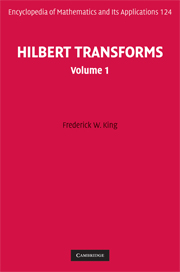Book contents
- Frontmatter
- Contents
- Preface
- List of symbols
- List of abbreviations
- 1 Introduction
- 2 Review of some background mathematics
- 3 Derivation of the Hilbert transform relations
- 4 Some basic properties of the Hilbert transform
- 5 Relationship between the Hilbert transform and some common transforms
- 6 The Hilbert transform of periodic functions
- 7 Inequalities for the Hilbert transform
- 8 Asymptotic behavior of the Hilbert transform
- 9 Hilbert transforms of some special functions
- 10 Hilbert transforms involving distributions
- 11 The finite Hilbert transform
- 12 Some singular integral equations
- 13 Discrete Hilbert transforms
- 14 Numerical evaluation of Hilbert transforms
- References
- Author index
- Subject index
14 - Numerical evaluation of Hilbert transforms
Published online by Cambridge University Press: 04 May 2010
- Frontmatter
- Contents
- Preface
- List of symbols
- List of abbreviations
- 1 Introduction
- 2 Review of some background mathematics
- 3 Derivation of the Hilbert transform relations
- 4 Some basic properties of the Hilbert transform
- 5 Relationship between the Hilbert transform and some common transforms
- 6 The Hilbert transform of periodic functions
- 7 Inequalities for the Hilbert transform
- 8 Asymptotic behavior of the Hilbert transform
- 9 Hilbert transforms of some special functions
- 10 Hilbert transforms involving distributions
- 11 The finite Hilbert transform
- 12 Some singular integral equations
- 13 Discrete Hilbert transforms
- 14 Numerical evaluation of Hilbert transforms
- References
- Author index
- Subject index
Summary
Introduction
Principal value integrals arise in a wide variety of applications, and in many cases it is not possible to evaluate such integrals in a simple closed analytic form. Consequently, there has been a significant investment of research effort devoted to the numerical evaluation of principal value integrals. The expression “numerical quadrature”, or frequently just the term “quadrature”, is used synonymously with numerical integration.
Some of the numerical integration approaches that have been developed for principal value integrals are outlined in this chapter. These range from rather simple schemes, which are sometimes quite effective, to approaches that yield fairly precise results and can be implemented in a high–speed calculation. Methods that are discussed include Maclaurin's formula, the trapezoidal rule, Simpson's formula, specialized Gaussian quadrature methods, and techniques involving Fourier transforms, including the fast Fourier transform, Fourier allied integral approaches, and methods based on conjugate Fourier series. Since a number of principal value integral problems arise in the context of transforming experimental data, some attention is devoted to the discretized nature of the data and how this can be handled.
Even if an analytic solution can be found for a particular principal value integral, numerical methods can be employed as a very useful check on the closed form result.
Some elementary transformations for Cauchy principal value integrals
Two straightforward, but potentially very useful, transformations that may be employed to simplify the evaluation of the Hilbert transform are discussed in this section.
- Type
- Chapter
- Information
- Hilbert Transforms , pp. 684 - 744Publisher: Cambridge University PressPrint publication year: 2009

